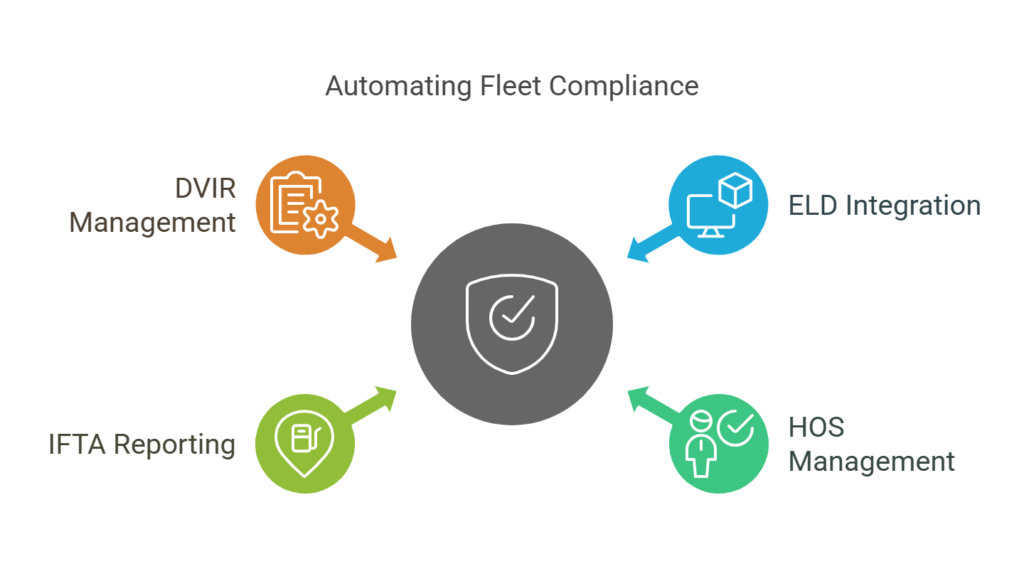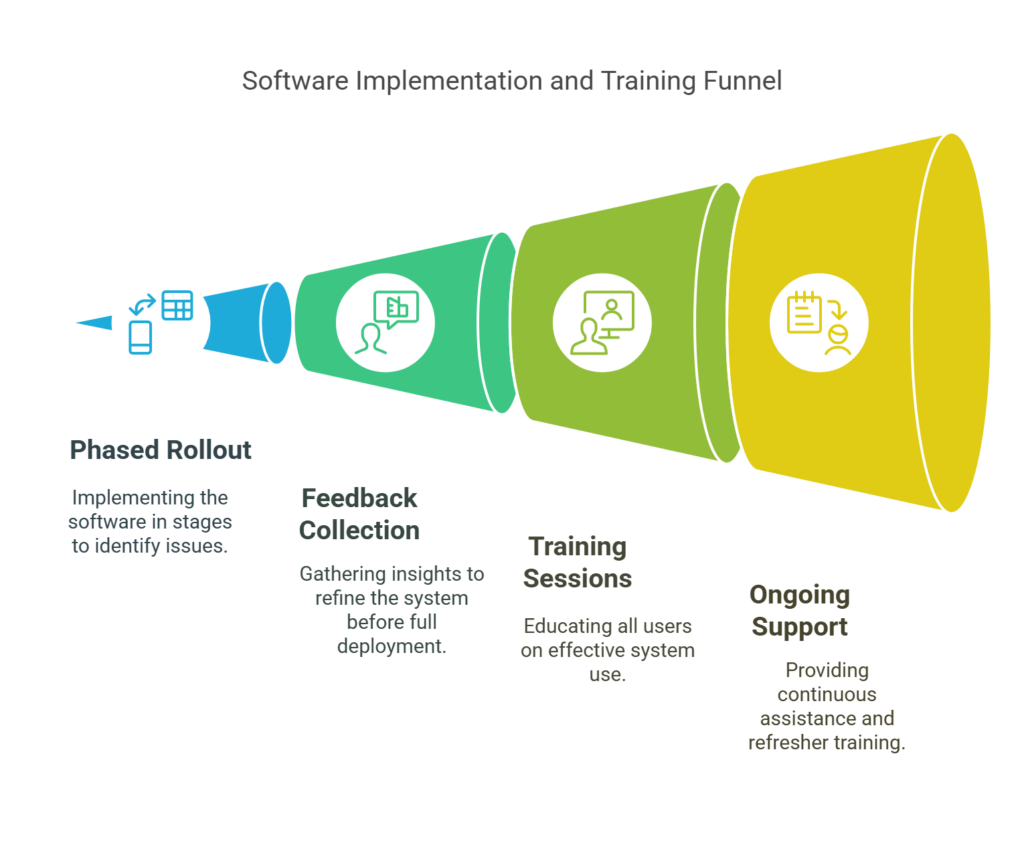Picture this: your fleet’s fuel costs drop by a whopping 25%, almost like magic. For trucking companies operating on tight margins, this isn’t just wishful thinking—it’s a very real possibility thanks to sophisticated truck fleet management software. These intelligent digital platforms are completely changing the game, offering everything from pinpoint GPS tracking in real-time to smart maintenance alerts that keep your rigs on the road and your business profitable.
We’re going to unpack how truck fleet management software is giving the trucking industry a major upgrade. You’ll see how these systems help map out the best routes, boost driver safety, and make compliance less of a headache—all contributing to a healthier bottom line. Whether you run a handful of local trucks or a massive long-haul operation, getting familiar with what modern fleet management technology can do is key to staying ahead in the fast-moving logistics arena.
Understanding Truck Fleet Management Software
So, what exactly is truck fleet management software? Think of it as a central command center for your entire trucking operation. It’s a specialized software suite designed specifically for the unique challenges of managing commercial trucks. Its core purpose is to monitor, manage, and optimize vehicles, drivers, fuel consumption, maintenance schedules, and regulatory compliance.
While general fleet management tools might cover cars or vans, truck-specific software dives deeper into aspects critical for heavy-duty vehicles. This includes monitoring engine hours, managing complex HOS (Hours of Service) rules, tracking IFTA fuel taxes, and dealing with the specific maintenance needs of large trucks. It goes beyond simple location tracking to provide a comprehensive overview of the fleet’s health and performance.
This technology has come a long way from basic GPS dots on a map. Early systems offered simple tracking, but today’s platforms incorporate telematics data, complex algorithms, and even AI to provide actionable insights. Its importance keeps growing as fuel prices fluctuate, regulations tighten, and customer demands for faster, more transparent shipping increase. It’s becoming less of a ‘nice-to-have’ and more of a ‘must-have’ for survival and growth. 🌱
“Fleet management software enables fleet managers to continually monitor their vehicles, equipment, and drivers from a single application.” -Teletrac Navman
Key Features of Truck Fleet Management Software
What makes this software tick? Several core features work together to deliver those impressive results. First up is real-time GPS tracking. Knowing precisely where every truck is at any given moment is fundamental. This isn’t just about location; it often includes speed, direction, and status updates, providing complete visibility.
Route optimization is another cornerstone. These tools analyze factors like traffic conditions, road restrictions (height, weight limits), delivery windows, and fuel stops to calculate the most efficient paths. Closely linked is fuel management, which involves monitoring fuel consumption, identifying wasteful driving habits (like excessive idling), and sometimes even integrating fuel card data to track expenses accurately.
Maintenance scheduling shifts from reactive repairs to proactive upkeep. The software tracks mileage, engine hours, and diagnostic trouble codes (DTCs) to predict potential issues and remind managers when preventative maintenance is due. This drastically cuts down on unexpected breakdowns and costly repairs. 🔧
Finally, compliance tools are essential. Features like electronic logging devices (ELDs) automate Hours of Service tracking, making it easier for drivers and managers to adhere to regulations. Automated IFTA reporting simplifies fuel tax calculations, saving hours of administrative work and reducing the risk of errors and fines. These features work in concert to streamline operations and boost profitability.
“Fleet management software schedules and tracks vehicle maintenance and repairs. It also can send reminders for routine servicing, track maintenance history, and generate reports so managers can feel assured their vehicles are properly maintained- reducing the risk of vehicle breakdowns and optimizing fleet performance.” -AssetWorks
Real-Time Tracking and Visibility
Knowing where your assets are in real-time isn’t just cool; it’s incredibly practical. Real-time GPS tracking, a core component of truck fleet management software, gives dispatchers unparalleled visibility. They can see exactly which truck is closest to a new pickup, assign jobs more effectively, and react swiftly to unexpected delays or changes.
This visibility directly translates to better customer service. Instead of vague delivery estimates, you can provide customers with highly accurate ETAs based on the truck’s current location and traffic conditions. This transparency builds trust and improves satisfaction. Need to know if a shipment will arrive before closing time? The software provides the answer. 👍
Beyond efficiency and customer happiness, real-time tracking significantly boosts security. It helps deter theft of vehicles and cargo, as assets can be monitored constantly. Geofencing features can alert managers if a truck deviates from its assigned route or enters/leaves a specific area unexpectedly, allowing for immediate action if something seems amiss.

Optimizing Routes and Fuel Efficiency
Fuel is often one of the biggest expenses for a trucking company. Truck fleet management software tackles this head-on with sophisticated route optimization tools. These aren’t just basic map apps; they consider truck-specific restrictions, delivery time windows, driver hours, and even historical traffic patterns to plot the most efficient course. 🗺️
Modern systems often integrate real-time traffic updates and weather forecasts. This allows for dynamic rerouting on the fly, helping drivers avoid congestion, accidents, or hazardous road conditions. Saving even a few miles or minutes on each trip adds up to substantial fuel and time savings across the entire fleet over weeks and months.
The software also analyzes historical data to identify consistently inefficient routes or driving patterns contributing to high fuel consumption. By understanding which routes perform best under certain conditions and coaching drivers on fuel-saving techniques (like smoother acceleration and reduced idling), companies can achieve significant reductions in their fuel spend. Data shows impressive results are possible.
“Truck cabs can save 20% to 25% on fuel expenses by implementing GPS vehicle monitoring technology as part of their fleet management strategy.” -LoadStop
Enhancing Driver Safety and Performance
Safety is paramount in the trucking industry. Truck fleet management software plays a vital role by monitoring driver behavior. Telematics data can track events like harsh braking, rapid acceleration, speeding, and sharp cornering. This information isn’t about playing ‘Big Brother’; it’s about identifying risky habits that need coaching.
Many systems offer driver scorecards, providing objective performance metrics. This allows managers to have constructive conversations with drivers, offering targeted training to improve safety. Some platforms even provide real-time audio or visual alerts in the cab to gently correct unsafe actions as they happen, promoting safer habits instantly.
Fatigue management is another critical safety aspect addressed by this software, particularly through integrated ELD functionality that tracks Hours of Service. By ensuring drivers stick to mandatory rest periods, the system helps prevent accidents caused by drowsiness. Improved safety records often lead to lower insurance premiums and, most importantly, fewer accidents and injuries. 🏆
Streamlining Maintenance and Reducing Downtime
An idle truck isn’t earning money. Truck fleet management software is key to minimizing costly downtime through proactive maintenance management. Instead of waiting for a breakdown, the system uses vehicle data (mileage, engine hours, sensor readings) to predict when maintenance is needed.
Automated alerts notify fleet managers about upcoming scheduled services (like oil changes or tire rotations) based on actual usage, not just fixed dates. More advanced systems monitor diagnostic trouble codes (DTCs) directly from the engine’s computer. Receiving an alert about a potential engine issue before it causes a roadside failure allows for scheduled repairs during off-hours, preventing major disruptions. 🛠️
Some software platforms even integrate with maintenance workshops. This can streamline the repair process by automatically transmitting diagnostic information, scheduling appointments, and tracking repair status and costs. Keeping detailed maintenance histories within the software also helps track trends, manage warranties, and make informed decisions about vehicle replacement.
Ensuring Regulatory Compliance
Staying compliant with the web of trucking regulations can feel like a full-time job. Truck fleet management software simplifies this significantly. Electronic Logging Devices (ELDs) mandated in many regions are often integrated directly, automatically recording driver Hours of Service (HOS) and eliminating the need for paper logs.
This automation drastically reduces the administrative burden and minimizes the risk of HOS violations, which can lead to hefty fines and impact safety ratings. Drivers find it easier to manage their hours, and managers have clear visibility into compliance status across the fleet. It makes roadside inspections smoother and less stressful.
Beyond HOS, the software often assists with International Fuel Tax Agreement (IFTA) reporting by automatically tracking miles driven and fuel purchased in each jurisdiction. It can also help manage Driver Vehicle Inspection Reports (DVIRs) electronically. Automating these critical compliance tasks frees up time, reduces errors, and helps maintain a good standing with regulatory bodies. ✅

Data Analytics and Business Intelligence
Modern truck fleet management software is more than just operational tools; they are powerful business intelligence platforms. They collect vast amounts of data from vehicles, drivers, and operations, turning it into easy-to-understand reports and dashboards. This provides deep insights into fleet performance.
Managers can track key performance indicators (KPIs) like fuel efficiency trends, average trip times, idle time percentages, driver safety scores, and maintenance costs per vehicle. Visual charts and graphs make it easy to spot trends, identify outliers, and understand the factors driving performance – both good and bad. 📊
This data empowers managers to make smarter, evidence-based decisions. Should a particular route be adjusted? Does a specific truck model consistently cost more to maintain? Are certain drivers excelling in fuel economy? Analyzing this information helps optimize everything from purchasing decisions to driver training programs, ultimately improving the fleet’s overall profitability and efficiency.
Integration with Other Business Systems
Truck fleet management software doesn’t operate in a vacuum. Its true power is often amplified when integrated with other essential business systems. Connecting it with your accounting software, for instance, can automate the flow of data related to fuel costs, maintenance expenses, and driver payroll, reducing manual data entry and errors.
Integration with Customer Relationship Management (CRM) systems can provide sales and support teams with real-time information on shipment status, enhancing communication with clients. Linking with Transportation Management Systems (TMS) or broader supply chain management tools creates a more unified view of logistics, improving planning and coordination across different departments and partners. Seamless data flow equals smoother operations. 🔗
Choosing the Right Truck Fleet Management Software
With various options available, selecting the right truck fleet management software requires careful consideration. Start by assessing your fleet’s specific needs. Are you primarily focused on compliance and basic tracking, or do you need advanced route optimization, fuel analysis, and maintenance features? The size and type of your fleet (long-haul, regional, vocational) will also influence your requirements.
Consider scalability. Will the software grow with your business? Look for a platform that can accommodate more vehicles and potentially offer more advanced features as your needs evolve. Ease of use is crucial for both managers and drivers – an intuitive interface ensures quicker adoption and better utilization. Don’t overlook the quality of customer support and training resources provided by the vendor. 🤔
Integration capabilities are also key. Check if the software can connect smoothly with your existing systems, like accounting or dispatch platforms. Compare pricing models – some charge per vehicle per month, others might have tiered feature levels. Request demos from shortlisted vendors to see the software in action and ensure it truly meets your operational goals.
Implementation and Training Best Practices
Choosing the software is just the first step; successful implementation is critical. Consider a phased rollout, perhaps starting with a small group of vehicles or one specific terminal. This allows you to iron out any kinks and gather feedback before deploying it across the entire fleet.
Thorough training for drivers, dispatchers, and managers is essential. Ensure everyone understands how to use the system effectively and recognizes the benefits it brings to their roles and the company. Address concerns openly and highlight how the software can make their jobs easier (e.g., automated logs, better route guidance). Ongoing support and refresher training sessions can also help maximize adoption and long-term success. 🙌

Future Trends in Truck Fleet Management Software
The world of truck fleet management software is constantly advancing. Artificial intelligence (AI) is playing an increasingly important role, powering more sophisticated predictive analytics for maintenance, route optimization that learns over time, and even AI-driven driver coaching.
Integration with developing autonomous vehicle technology is another horizon. Fleet management platforms will be central to monitoring and managing mixed fleets of human-driven and autonomous trucks. Furthermore, technologies like blockchain are being explored for enhancing supply chain transparency and security, potentially integrating with fleet data for verified tracking and documentation. Expect even smarter, more connected systems ahead. ✨
FAQ: Common Questions About Truck Fleet Management Software
What is the primary purpose of truck fleet management software?
The main goal is to give fleet managers the tools to monitor, control, and optimize their trucking operations. This involves tracking vehicle locations, improving fuel efficiency, managing maintenance schedules, ensuring driver safety and compliance, and using data to make better business decisions, all aimed at increasing efficiency and profitability.
How much does truck fleet management software typically cost?
Costs vary widely based on the provider, the features included, and the number of vehicles. Pricing is often structured on a per-vehicle, per-month basis, potentially ranging from $15 to $50+ per truck. Some providers might have setup fees or hardware costs (like for ELDs or cameras). It’s best to get quotes based on your specific needs.
Can truck fleet management software work with existing hardware in my vehicles?
Sometimes, yes. Many software providers offer solutions compatible with existing telematics devices or ELDs already installed in your trucks, especially if they use standard protocols. However, compatibility isn’t guaranteed, and some systems require proprietary hardware for full functionality. Always check with the software vendor about hardware compatibility.
How does truck fleet management software improve fuel efficiency?
It improves fuel efficiency in several ways: optimizing routes to minimize mileage, reducing engine idling time through monitoring, tracking fuel consumption to identify inefficient vehicles or driving habits, providing data for driver coaching on fuel-saving techniques (like smooth acceleration/braking), and ensuring proper vehicle maintenance for optimal engine performance.
Is truck fleet management software suitable for small fleets?
Absolutely! While large fleets see substantial benefits, small fleets can gain significant advantages too. Many providers offer scalable solutions with pricing and feature sets suitable for smaller operations (even just a few trucks). The efficiency gains, compliance help, and cost savings can be just as impactful, proportionally, for a small business.
Conclusion
Truck fleet management software has moved far beyond simple tracking; it’s now a comprehensive command center for modern trucking operations. From optimizing routes and slashing fuel costs to ensuring safety, streamlining maintenance, and simplifying compliance, the benefits are clear and substantial. It provides the visibility and control needed to operate efficiently in a demanding industry.
Adopting this technology is no longer just an option for staying competitive—it’s becoming essential. The ability to leverage real-time data, automate processes, and make informed decisions gives fleets a critical edge. Investing in the right truck fleet management software is investing in the future success and sustainability of your business.
For fleet managers ready to transform their operations, Nektar.io offers state-of-the-art truck fleet management software designed for your unique needs. Our platform blends robust features with an easy-to-use interface, making sure you can unlock your fleet’s full potential without getting bogged down by complexity. Visit Nektar.io today to book a demo and see how our software can power your fleet’s journey to success. 🚀
Key Takeaways:
- Truck fleet management software can substantially cut operational costs, with fuel savings potentially reaching 25%.
- Real-time tracking and smart route optimization boost efficiency and keep customers happy.
- Predictive maintenance capabilities minimize unexpected downtime and help vehicles last longer.
- Automated tools for compliance lessen the risk of regulatory penalties and fines.
- Data analytics offer valuable insights for strategic choices and ongoing improvements.



